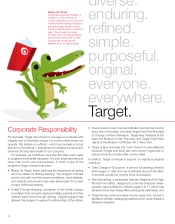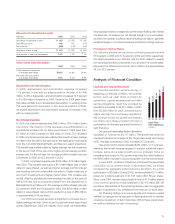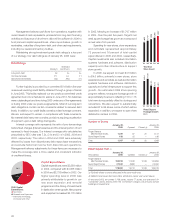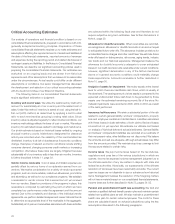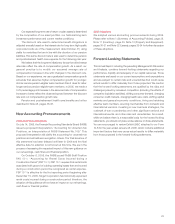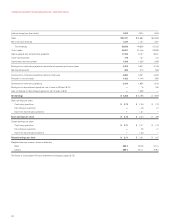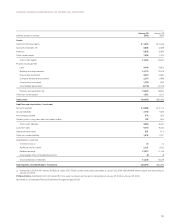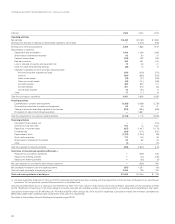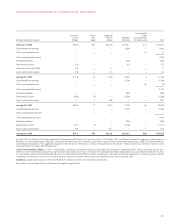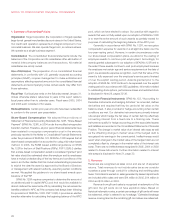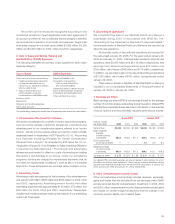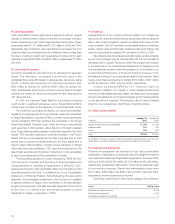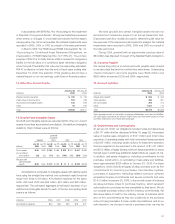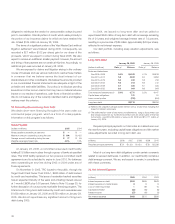Target 2005 Annual Report Download - page 24
Download and view the complete annual report
Please find page 24 of the 2005 Target annual report below. You can navigate through the pages in the report by either clicking on the pages listed below, or by using the keyword search tool below to find specific information within the annual report.
22
Critical Accounting Estimates
Our analysis of operations and financial condition is based on our
consolidated financial statements, prepared in accordance with U.S.
generally accepted accounting principles. Preparation of these
consolidated financial statements requires us to make estimates and
assumptions affecting the reported amounts of assets and liabilities at
the date of the financial statements, reported amounts of revenues
and expenses during the reporting period and related disclosures of
contingent assets and liabilities. In the Notes to Consolidated Financial
Statements, we describe our significant accounting policies used in
preparing the consolidated financial statements. Our estimates are
evaluated on an ongoing basis and are drawn from historical
experience and other assumptions that we believe to be reasonable
under the circumstances. Actual results could differ under different
assumptions or conditions. Our senior management has discussed
the development and selection of our critical accounting estimates
with the Audit Committee of our Board of Directors.
The following items in our consolidated financial statements
require significant estimation or judgment:
Inventory and cost of sales We utilize the retail inventory method to
account for substantially all of our inventory and the related cost of
sales. Under this method, inventory is stated at cost, using the last-in,
first-out (LIFO) method, as determined by applying a cost-to-retail
ratio to each merchandise grouping’s ending retail value. Since
inventory value is adjusted regularly to reflect market conditions, our
inventory methodology reflects the lower of cost or market. We reduce
inventory for estimated losses related to shrinkage and markdowns.
Our shrink estimate is based on historical losses verified by ongoing
physical inventory counts. Markdowns designated for clearance
activity are recorded when the salability of the merchandise has
diminished. Inventory is at risk of obsolescence if economic conditions
change. Examples of relevant economic conditions include shifting
consumer demand, changing consumer credit markets or increasing
competition. We believe these risks are largely mitigated because
substantially all of our inventory sells in less than six months. Inventory
is further described in Note 11, page 30.
Vendor income receivable Cost of sales and SG&A expenses are
partially offset by various forms of consideration earned from our
vendors. We receive consideration for a variety of vendor-sponsored
programs, such as volume rebates, markdown allowances, promotions
and advertising, as well as for our compliance programs. We establish
a receivable for vendor income that is earned but not yet received
from our vendors. Based on provisions of the programs in place, this
receivable is computed by estimating the point at which we have
completed our performance under the agreement and the amount
earned. Due to the complexity and diversity of the individual vendor
agreements, we perform detailed analyses and review historical trends
to determine an appropriate level of the receivable in the aggregate.
Substantially all of year-end receivables associated with these activities
are collected within the following fiscal year and therefore do not
require subjective long-term estimates. See further discussions in
Note 4, page 29.
Allowance for doubtful accounts When receivables are recorded,
we recognize an allowance for doubtful accounts in an amount equal
to anticipated future write-offs. This allowance includes provisions for
uncollectible finance charges and other credit fees. We estimate future
write-offs based on delinquencies, risk scores, aging trends, industry
risk trends and our historical experience. Management believes the
allowance for doubtful accounts is adequate to cover anticipated
losses in our credit card accounts receivable under current conditions;
however, significant deterioration in any of the factors mentioned
above or in general economic conditions could materially change
these expectations. Accounts receivable is further described in
Note 10, page 30.
Analysis of assets for impairment We review assets at the lowest
level for which there are identifiable cash flows, which is usually at
the store level. The carrying amount of store assets is compared to the
expected undiscounted future cash flows to be generated by those
assets over the estimated remaining economic life of the store. No
material impairments were recorded in 2005, 2004 or 2003 as a result
of the tests performed.
Insurance/self-insurance We retain a substantial portion of the risk
related to certain general liability, workers’ compensation, property
loss and employee medical and dental claims. Liabilities associated
with these losses include estimates of both claims filed and losses
incurred but not yet reported. We estimate our ultimate cost based
on analysis of historical data and actuarial estimates. General liability
and workers’ compensation liabilities are recorded at our estimate of
their net present value; other liabilities are not discounted. We believe
the amounts accrued are adequate, although actual losses may differ
from the amounts provided. We maintain stop-loss coverage to limit
the exposure related to certain risks.
Income taxes We pay income taxes based on the tax statutes,
regulations and case law of the various jurisdictions in which we
operate. Income tax expense involves management judgment as to
the ultimate resolution of any tax matters in dispute with state and
federal tax authorities. Historically, our assessments of the ultimate
resolution of tax issues have been reasonably accurate. The current
open tax issues are not dissimilar in size or substance from historical
items. Management believes the resolution of the foregoing matters
will not have a material impact on our consolidated financial statements.
Income taxes are further described in Note 23, pages 34-35.
Pension and postretirement health care accounting We fund and
maintain a qualified defined-benefit pension plan and maintain certain
related non-qualified plans as well. We also maintain a postretirement
health care plan for certain retired employees. The costs for these
plans are calculated based on actuarial calculations using the key
assumptions discussed in the following paragraphs.




